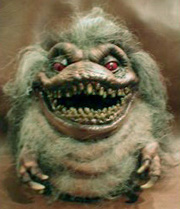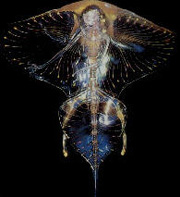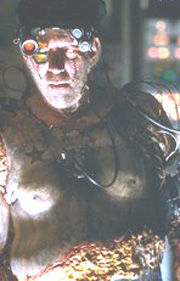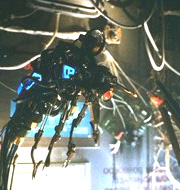Earthbased Species, Part IV
The Judas Breed
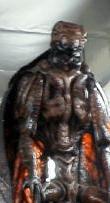
When Stricklers Disease struck the city of New York, it wiped out thousands, many of whom were small children. The disease had no cure, and no vaccine. In order to wipe out the disease, the authorities decided to go after the carrier - cockroaches. But cockroaches are very resilient, and chemical control was useless, so the authorities turned to the CDC to create a new insect, one that would wipe out the cockroach populations - they created the Judas Breed. The Judas Breed were created in the genetic labs - a new species created by splicing cockroach, mantis and termite DNA. They were to be mans ally against the cockroaches, producing an enzyme which caused the cockroach's metabolism to go into overdrive, making them starve to death. They were introduced into the sewer systems where the cockroaches lived and within days every cockroach was dead - the disease was contained.
The Judas Breed were created to undergo rapid enzymatic change due to the recombinant DNA and a suicide gene was introduced to create a life expectancy of 120-180 days. But something went wrong. They survived. When the Judas Breed was created, their metabolism was sped up. They bred faster. Many generations passed in a short space of time - which meant more mutations. And these mutations were acted upon by evolution - those that were beneficial to the species were passed on to further generations. Life expectancy increased, and the suicide gene disappeared from the gene pool. Over a three year period the Judas Breed rapidly evolved. Like many species in the earth based animal kingdom, the Judas Breed evolved to mimic their predators. Man. They evolved to imitate us, infiltrate us, and breed a legion.
The Judas Breed are born from an ootheca, or egg case, which contains many young insects. These egg cases are a dark orange in colour and have a gelatinous consistency. They are roughly 60 cm across, by 35 cm high and are usually found attached to a wall or other large object by some form of resin-like residue. Once hatched, a young Judas Breed nymph is approximately 20 cm long, with a hard brown/orange chitinous exoskeleton and resembled a large Hissing Cockroach. They have six legs, each of which ends in a very sharp point, and three sets of wings. Even at this young age, the Judas Breed are very vicious and will attack if threatened.
Adult Judas Breed have evolved to mimic humans. They possess six legs, wings, a head, thorax and abdomen like normal earth based insects, but they do not look like insects at first glance. The Judas Breed are the size of adult humans, having evolved lungs (the lack of which ensures insects stay relatively small) through mutation in successive generations. They walk upright on their two hind legs, keep their middle set of legs (like those of a Praying Mantis) close to their body, and use their two fore legs to cover their face. They wrap their wings tightly around their bodies, giving them the rough form of a human in a long coat. Perhaps most amazing of all, the Judas Breed have evolved structures on its forelimbs that when placed together in front of their head make up two halves of a hard chitinous plate that strongly resembles the human face.
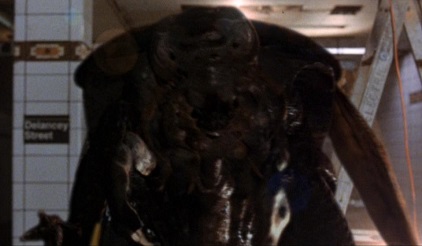
With this structure in place and its' wings wrapped tightly around it, the Judas Breed looks very human in the half light and casts a convincing shadow and silhouette. The Judas Breed are deadly predators and will fight to the death if confronted, no matter how badly injured they become. The Judas Breed is attracted to the smell of blood, and will either kill its prey and consume them on the spot, or they will stun them and carry them to a form of pantry. They can sense chemical changes and identify each other by their scent. Communication is achieved by a clicking sound produced by the mouthparts. The Judas Breed roost like bats, hanging upside down in large colonies. They excrete on the ceiling.
The adult Judas Breed live in sheltered colonies, with a caste system similar to that of termites. There is one fertile male and the female soldier caste lives to serve him. The male of the species is larger than the females, of a lighter colouring, and does not possess wings. He moves using his four hind legs, while his two lead legs are used as mantis-like forearms. Due to the Judas Breed’s increased metabolism and breed rate, they go through many generations in a short time. As mutations occur in each generation, if a section of the Judas Breed species is separated from the main population and continue to evolve under new environmental circumstances, they will eventually reach a point where they have mutated to be so different as to be classed as a new genus of the original Judas Breed species. This is the Judas Breed - Genus 2.
The Judas Breed - Genus 2
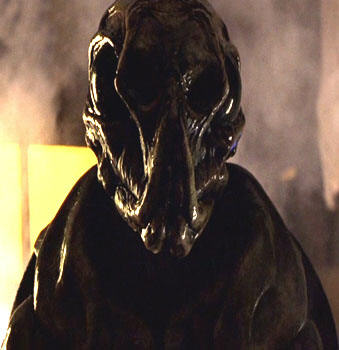
As the original Judas Breed species migrated through the underground systems of New York, a section of the species became separated from the main population. As this group bred, it went through many generations - and mutations - in a short time period due to the Judas Breed’s increased metabolic rate. Eventually this sub-population of Judas Breed insects reached a point where it was so different from the original species that it could now be classed as a new genus (sub-species) of the original species.
The Judas Breed - Genus 2 are very similar to the original Judas Breed species that they evolved from. They establish satellite colonies, and will instinctively defend their nests to the death. Like a cockroach which can continue to live for approximately nine days after decapitation, the Judas Breed G2 is very tough and can survive for a time even after sever harm or dismemberment. Also like cockroaches, the Judas Breed is capable of climbing vertical walls, running across ceilings, hanging upside down and laterally compressing its body; flattening itself so that it can crawl inside wall crevices. They are very strong and are capable of lifting over 200 pounds in weight and carrying it straight up vertical surfaces as well as pulling adult human bodies through spaces smaller than their area.
The Judas Breed began as a new species created by splicing cockroach, mantis and termite DNA, and consequently the Judas Breed G2 still possesses many cockroach-like behavioural traits. They exhibit a remarkable capacity for insight learning - they learn from their own mistakes. They are also negatively phototactic (they run from light) and figmotactic (they like tight, confined spaces), and possess sensors that detect subtle variations in air movement (so running will attract them a lot faster than walking) and pheromones (such as those given off by sweat). Therefore if the Judas Breed G2 is encountered, researchers should keep away from walls and large clustered objects, stick to the centre of corridors or rooms, walk slowly, try to keep their breathing shallow, and avoid sweating.
This new genus of the Judas Breed may be very similar to the original Judas Breed species, but they also exhibit many differences. The Judas Breed G2 seems to be composed (paradoxically) of a mainly male colony, with only one fertile female. This is in direct contrast to the original Judas Breed species which was comprised mainly of females with only one fertile male, and can only possibly be attributed to the Judas Breed G2’s unique environmental factors governing their evolution.
The Judas Breed G2 offspring is different from the original Judas Breed offspring as well. The new genus start as larva which (like maggots) eat dead and decaying flesh, and secrete a mucus which staunches bleeding. From this stage, they develop into nymphs, which appear slightly smaller than the original Judas Breed nymphs, and are different in colouration and appearance. These nymphs are very fast, with legs ending in sharp claws, and will attack in swarms when threatened. Perhaps the most obvious difference in the Judas Breed G2 is their physiological makeup. Their chitinous body armor appears stronger; the cuticle seemingly impossible to puncture. The mantis-like forearms appear thicker, more pronounced, and sharper. They also leave a visible trail which glows under black light when they crawl across surfaces, which the original Judas Breed did not appear to do.
The main physiological difference in the Judas Breed G2 is in their more advanced ability to mimic humans. While retaining the human-like stance and body shape of the original Judas Breed by standing on their back set of legs and wrapping their wings around their bodies, the Judas Breed G2 now possesses an almost completely reconfigured ability to mimic the human head. The original Judas Breed had evolved half-face plates on their forearms which they held together in front of their heads to give the appearance of a human face. The Judas Breed G2 however, has evolved a new structure, completely replacing the forearm half-face plates, which appear to have been phased out during evolution.
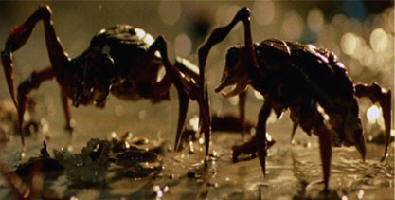
The Judas Breed G2 has developed a casing which completely envelopes their whole head. This casing appears to be an evolved adaptation of vestigial wings, each wing representing half of the human head. This mimicry structure is folded up behind its back when the Judas Breed G2’s head is revealed, but can quickly be unfolded to give a human appearance. A worrying feature of this new genus of Judas Breed is that they now appear to be able to mimic specific humans. How they are able to do this exactly has baffled scientists here at NCXRI, but it evidently has something to do with the Judas Breed G2 insect tearing the face off of the human that it is going to mimic. What exactly it does with this face, or how it is able to reconfigure its mimicry head structure to match it is still a mystery. The most worrying (yet incredible) feature of the Judas Breed G2 is that they appear to have to ability to metamorph even further. During molting, they can shed their outer casing, metamorphing into a new instar. This new instar appears as the perfection of the Judas Breed mimicking process, looking almost exactly like the specific human which the Judas Breed G2 insect has chosen to mimic.
A soft skin-like covering encases the insects head and forearms, giving the appearance of human flesh. Though it is highly reflective, smooth, rubber-like and low detailed, the human mimicry is astounding, coupled with the fact that the insect actually wears its human victims clothing. In all, this new development could prove very dangerous for mankind.

